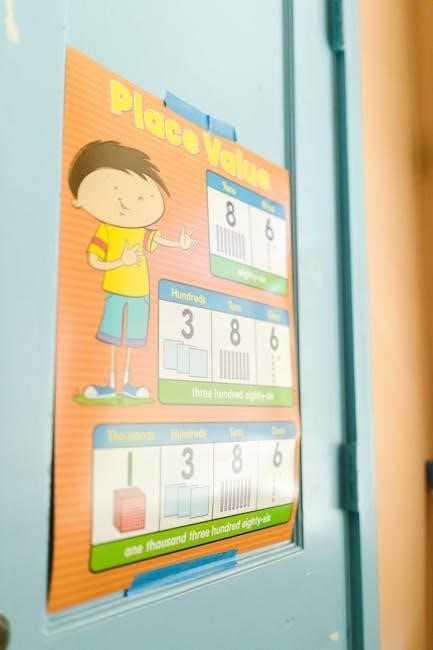A place value chart is a visual tool that helps students understand the value of each digit in a number, enhancing their math skills effectively.
1.1 What is a Place Value Chart?
A place value chart is a visual tool used to help students understand the value of digits in numbers. It organizes digits into columns representing ones, tens, hundreds, and thousands, making it easier to comprehend place value concepts. The chart provides a clear structure for identifying and comparing the values of digits within a number. It is often printable in PDF format, allowing teachers and parents to use it effectively in educational settings. This tool is essential for building foundational math skills in students of various grade levels.
1.2 Importance of Place Value in Mathematics
Place value is a fundamental concept in mathematics, forming the basis for understanding number systems. It helps students recognize the value of each digit within a number, enabling them to perform arithmetic operations like addition and subtraction accurately. Mastery of place value enhances problem-solving skills and lays the groundwork for more complex math concepts. It also aids in real-world applications, such as handling money and telling time, making it an essential skill for lifelong learning and academic success.

Benefits of Using a Printable PDF Place Value Chart
Printable PDF place value charts offer convenience, customization, and cost-effectiveness. They provide clear visual aids, are easily accessible, and can be laminated for reusable learning tools, enhancing math skills effectively.
2.1 Convenience and Accessibility
Printable PDF place value charts are highly convenient, offering easy access for teachers and students. They can be downloaded instantly and used across various devices, making them ideal for both classroom and home learning. The PDF format ensures compatibility and high-quality printing, while the ability to laminate or use sheet protectors allows for reusable resources. This accessibility makes learning place value concepts flexible and efficient, catering to different learning environments and preferences. Additionally, they can be shared digitally, promoting collaborative learning and reducing preparation time for educators.
2.2 Customization Options
Printable PDF place value charts offer extensive customization, allowing educators to tailor resources to specific grade levels and learning needs. Teachers can modify charts to include decimals, thousands, or millions, ensuring relevance for diverse curricula. Adding visual aids, colors, and interactive elements enhances engagement. Customization options also enable the creation of reusable materials through laminating or sheet protectors, making them adaptable for various teaching strategies and student requirements, thus providing a flexible and effective learning tool for mathematics education.
2.3 Cost-Effective Learning Tool
Printable PDF place value charts are a cost-effective learning tool, offering accessibility without financial strain. They are often free or low-cost, making them ideal for schools and homeschooling. These charts eliminate the need for expensive manipulatives, providing a budget-friendly alternative. Teachers can print multiple copies, ensuring every student has access. Additionally, reusable options like laminating or sheet protectors extend their longevity, reducing the need for frequent replacements and supporting eco-friendly practices. This affordability makes them a valuable resource for educators facing budget constraints, ensuring high-quality math education remains accessible to all students.

Key Features of a Place Value Chart
A place value chart typically includes columns for ones, tens, hundreds, and thousands, sometimes extending to decimals. Visual aids like icons or colors enhance understanding and engagement.
3.1 Structure: Ones, Tens, Hundreds, Thousands
A place value chart is organized into columns representing ones, tens, hundreds, and thousands. Each column helps students identify the positional value of digits in a number. For example, the number 4,253 is broken down into 3 ones, 5 tens, 2 hundreds, and 4 thousands. This clear structure aids in understanding how numbers are composed, making arithmetic operations like addition and subtraction more intuitive. The chart’s grid layout provides visual clarity, essential for teaching place value concepts effectively in classrooms.
3.2 Decimal Place Value Extensions
Decimal place value extensions expand the chart beyond whole numbers, introducing tenths, hundredths, and thousandths. This feature helps students transition smoothly from whole number place value to decimals, enhancing their understanding of fractions and monetary concepts. Visual aids like lines or colors differentiate whole numbers from decimals, ensuring clarity. Teachers often use these charts to teach real-world applications, such as money, measurements, and weights, making complex decimal relationships accessible and engaging for learners of all ages.
3.4 Visual Representation for Better Understanding
Visual representations in place value charts, such as grids or diagrams, make abstract concepts tangible. These tools use color coding, lines, or boxes to distinguish places like ones, tens, and hundreds, helping students visualize digit relationships. Decimal extensions add tenths, hundredths, and thousandths, with clear separators to avoid confusion. Such visuals bridge the gap between concrete and abstract thinking, enabling learners to grasp place value intuitively and apply it to real-world problems with confidence and accuracy.

How to Use a Place Value Chart in the Classroom
Use manipulatives like cubes to teach tens and ones. Step-by-step instruction helps students understand digit placement. Printable grids and real-world examples enhance engagement and comprehension effectively.
4.1 Step-by-Step Teaching Guide
Begin by introducing the concept of place value using a printable PDF chart. Start with ones, tens, and hundreds, gradually progressing to thousands. Use manipulatives like cubes to demonstrate how numbers are built. Highlight each digit’s position and value, ensuring students understand the relationship between places. Provide guided practice with real-world examples, such as counting money or measuring lengths. Encourage students to fill in blank charts independently, reinforcing their understanding of each place value.
4.2 Incorporating Manipulatives for Hands-On Learning
Enhance place value lessons by using manipulatives like cubes, blocks, or counters alongside printable PDF charts. These tools allow students to physically represent numbers, breaking them into ones, tens, and hundreds. For example, base-ten blocks can illustrate how units combine to form tens and hundreds. This tactile approach engages students, making abstract concepts tangible. Pairing manipulatives with charts reinforces understanding, as students can visualize and construct numbers while referencing the chart’s structure.
4.3 Assessing Student Understanding
Regularly assess students’ grasp of place value by incorporating quizzes, class discussions, and hands-on activities. Use printable PDF charts to create formative assessments, ensuring alignment with curriculum goals. Observe students during lessons to identify misconceptions and provide immediate feedback. Administer short tests to evaluate their ability to identify and write numbers using place value concepts. Hands-on tasks, like building numbers with manipulatives, further validate their understanding and readiness for advanced topics.

Printable PDF Options and Sources
Discover free and high-quality printable PDF place value charts from reputable educational websites, designed to support teachers and parents in effective math instruction and student learning.
5.1 Free Resources for Teachers and Parents
Teachers and parents can access free printable PDF place value charts from various educational websites. These resources are designed to be easy to download and print, offering a convenient way to introduce students to place value concepts. Many websites provide customizable charts to suit different grade levels and learning needs. Popular options include blank charts for thousands, hundreds, tens, and ones, as well as decimal place value extensions. These tools are ideal for classroom use or homeschooling, making math lessons engaging and effective.
5.2 Websites Offering High-Quality PDF Charts
Several websites provide high-quality, printable PDF place value charts designed for educational use. Popular options include Math Aids, Education;com, and Teachers Pay Teachers. These sites offer customizable charts that cater to different grade levels and learning needs. Many charts are available in both color and black-and-white versions, with options for lamination. They cover a range of place values, from basic ones, tens, and hundreds to more complex millions and billions, as well as decimal place value extensions.
5.3 Downloading and Printing Tips
When downloading printable PDF place value charts, ensure the file is high-resolution for clarity. Choose charts that match your students’ grade level and learning needs. Print on sturdy paper or cardstock for durability. Adjust printer settings to ‘actual size’ to maintain the chart’s structure. For long-term use, consider laminating the printed chart. Websites like Teachers Pay Teachers and Math Aids offer excellent options for educational use.

Advanced Place Value Concepts
Advanced place value concepts include understanding millions, billions, and decimal extensions, enabling students to grasp larger numbers and precise decimal values effectively in real-world applications.
6.1 Understanding Millions and Billions
Understanding millions and billions using a place value chart extends students’ grasp of large numbers. The chart visually organizes each digit’s place, from ones up to millions and billions, making complex concepts manageable. This tool helps students recognize patterns and relationships between digits in larger numbers. By breaking down numbers into millions and billions, students can better comprehend their magnitude and apply this understanding to real-world problems, enhancing their mathematical proficiency and problem-solving skills effectively.
6.2 Exploring Decimal Place Value
Decimal place value charts extend understanding beyond whole numbers by introducing tenths, hundredths, thousandths, and more. These charts help students visualize how digits represent fractions of a whole, aligning with whole number systems. By marking each decimal place, students can recognize patterns and relationships, such as how tenths relate to ones. This tool bridges whole number and decimal concepts, aiding in operations like addition and subtraction of decimals, and enhancing overall mathematical fluency in handling both whole and fractional values effectively.
6.3 Applying Place Value to Real-World Problems
Place value charts are invaluable for connecting abstract math to real-world scenarios, such as budgeting, cooking, or telling time. For instance, understanding place value aids in calculating total costs when shopping or measuring ingredients accurately. By applying place value concepts to practical tasks, students develop problem-solving skills and recognize the relevance of math in daily life, making learning more engaging and meaningful. This bridge between theory and application fosters a deeper understanding of numerical relationships and their practical uses.

Creating a Custom Place Value Chart
Tailor a place value chart to specific learning needs, using colors and images for clarity. Ensure it’s organized, adaptable, and engaging for all age groups.
7.1 Designing for Specific Grade Levels
Designing a custom place value chart for specific grade levels ensures it meets students’ developmental needs. For younger grades, use larger fonts and visuals, while for older students, include more complex place values like millions. Tailor the chart to align with curriculum standards, incorporating manipulatives for hands-on learning. Use colors to differentiate place values, making the chart engaging and easy to understand for all skill levels. This approach fosters a deeper grasp of numerical concepts.
7.2 Adding Visual Aids and Colors
Enhance place value charts with vibrant colors and visual aids to capture students’ attention. Use distinct hues for ones, tens, hundreds, and thousands to help differentiate each place value. Incorporate icons or symbols to represent digits, making abstract concepts more tangible. Visual aids like arrows or blocks can illustrate how digits relate within a number. This engaging approach makes learning interactive and fosters a clearer understanding of numerical relationships, especially for visual learners.
7.3 Laminating for Reusability
Laminating your place value chart ensures durability and longevity, making it resistant to wear and tear. This method allows for easy cleaning with a damp cloth, preserving the chart for repeated use. Teachers can laminate printed charts or place them in sheet protectors for added protection. Laminated charts can also be used with dry-erase markers, enabling interactive lessons and assessments. This cost-effective approach extends the chart’s lifespan, supporting long-term educational use in classrooms and homeschooling environments.

Integrating Technology with Place Value Charts
Integrate technology by using digital tools like Google Slides or PowerPoint for interactive place value lessons. PDF editors enable customization, enhancing engagement and accessibility for modern learners.
8.1 Digital Tools for Interactive Learning
Digital tools like Google Slides and PowerPoint offer interactive ways to teach place value. Educators can create slide presentations with animations and real-time collaboration. PDF editors allow customization of printable charts, while interactive whiteboards enable hands-on activities. Apps and online platforms provide games and exercises for practice. These tools make learning engaging and accessible, catering to diverse learning styles. They also support remote education, ensuring students can practice place value concepts anytime, anywhere.
8.2 Using Google Slides and PowerPoint
Google Slides and PowerPoint are excellent for creating interactive place value lessons. Teachers can design slides with animations, drag-and-drop activities, and embedded PDF charts. These platforms allow real-time collaboration, making group work engaging. Educators can also embed videos and links for additional resources. Customizable templates enable tailored lessons for different grade levels. By sharing presentations via links, students can access materials anytime, fostering flexible and dynamic learning experiences that enhance understanding of place value concepts.
8;3 PDF Editors for Customization
PDF editors are powerful tools for customizing place value charts. They allow educators to add text, images, or colors to enhance clarity. Features like drag-and-drop functionality and annotation options make it easy to tailor charts to specific learning needs. Teachers can modify existing PDF templates to include visual aids or align content with curriculum standards. This flexibility ensures that place value charts remain engaging and effective for diverse student groups, enhancing the overall teaching experience and student understanding.

Common Mistakes to Avoid
Common mistakes include misaligning digits in their respective places, confusing decimal and whole number systems, and skipping intermediate steps, which can hinder effective place value understanding.
9.1 Misaligning Digits in Their Respective Places
Misaligning digits is a common error where students incorrectly place numbers, such as putting the tens digit in the hundreds column. This confusion can lead to incorrect number values. Using a printable PDF place value chart helps by visually separating each place, reducing alignment mistakes. Teachers should emphasize proper placement and provide guided practice to reinforce correct digit positioning. Regular checks and immediate feedback can prevent this error from becoming a habit and ensure accurate understanding of place value concepts.
9.2 Confusing Decimal and Whole Number Systems
Confusing decimal and whole number systems is a common mistake, especially when digits are misplaced. For example, misaligning the decimal point can lead to incorrect values. A printable PDF place value chart can help by clearly separating whole numbers and decimals, visually distinguishing the two systems. Teachers should emphasize the difference between place value in whole numbers (ones, tens, hundreds) and decimals (tenths, hundredths, thousandths). Regular practice with labeled charts ensures students understand the distinction, reducing errors and improving overall number sense. This clear separation is crucial for accurate calculations and problem-solving in higher-level math.
9.3 Skipping Intermediate Steps
Skipping intermediate steps is a common mistake that can lead to misunderstanding place value concepts. Students often rush through problems, neglecting to break down numbers into their component parts. A printable PDF place value chart helps by visually separating digits into ones, tens, hundreds, and thousands, encouraging a step-by-step approach. Teachers should emphasize the importance of analyzing each place value individually to build a strong foundation in number sense and prevent errors in more complex calculations.
A place value chart printable PDF is an effective tool for teaching number structure, offering versatility and customization to suit various learning needs and grade levels.
10.1 Summary of Key Points
Place value charts are essential tools for teaching number structure, offering clear visual representations of digits’ values. They enhance understanding of place value concepts, from ones to billions, and are adaptable to various learning environments. Customizable PDF versions provide flexibility for different grade levels and learning needs. These charts support hands-on learning, digital integration, and real-world problem-solving, making them invaluable for math education. Consistent practice with place value charts ensures mastery of foundational mathematical concepts.
10.2 Encouraging Continuous Practice
Regular practice with place value charts reinforces mathematical fluency and confidence. Teachers and parents can incorporate these tools into daily routines, using them for homework assignments or interactive games. Laminated charts allow for reusable write-and-wipe activities, making practice convenient. Encouraging students to apply place value skills to real-world problems further solidifies their understanding. Consistent exposure ensures long-term retention and mastery of this foundational math concept.
- Use charts for daily drills and interactive games.
- Incorporate manipulatives like coins or blocks for hands-on learning.
- Encourage applying place value to real-world scenarios.
10.3 Final Thoughts on the Effectiveness of Place Value Charts
Place value charts are invaluable tools for teaching mathematical concepts, offering clarity and structure for students. Their visual nature simplifies complex ideas, making them accessible to learners of all levels. Whether printed or digital, these charts provide a reusable and adaptable resource that supports long-term understanding. By combining hands-on activities with visual aids, educators can ensure a strong foundation in place value, preparing students for advanced math challenges.
Key benefits: Reusability, visual clarity, and adaptability for diverse learning needs.

Additional Resources
Explore free PDFs, educational websites, and downloadable templates to enhance place value learning. Visit recommended sites for high-quality charts and printable materials tailored for classroom use;
11.1 Recommended Websites for Further Learning
For additional resources, visit Math-Drills, Teachers Pay Teachers, and Education.com. These websites offer a wide range of free and premium place value charts, worksheets, and interactive tools. Math-Drills provides detailed PDF charts, while Teachers Pay Teachers offers customizable templates. Education.com features interactive games and activities to reinforce place value concepts. Explore these sites to find materials that suit your teaching or learning needs, ensuring a comprehensive understanding of place value systems;
11.2 Suggested Worksheets and Activities
Enhance learning with fill-in-the-blank exercises, matching games, and number-building tasks. Use PDF worksheets from Math-Drills for structured practice. Incorporate Google Slides activities from Teachers Pay Teachers for interactive lessons. Try place value scavenger hunts and digital sorting games from Education.com to engage students. These resources cater to different learning styles, making place value concepts accessible and enjoyable for all learners.
11.3 Books for In-Depth Study
For a deeper understanding, explore books like “Place Value” by Catherine Twomey Fosnot and “Mathematics for Elementary Teachers” by John A. Carter. These texts provide comprehensive insights into place value concepts, offering practical activities and real-world applications. They are ideal for teachers and parents seeking to reinforce learning. Visit Amazon or educational publishers for these resources, ensuring a solid foundation in place value for students of all ages.

